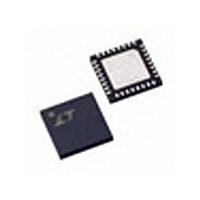LTC3770EUH#TR Linear Technology, LTC3770EUH#TR Datasheet - Page 14

LTC3770EUH#TR
Manufacturer Part Number
LTC3770EUH#TR
Description
Manufacturer
Linear Technology
Datasheet
1.LTC3770EUHTR.pdf
(24 pages)
Specifications of LTC3770EUH#TR
Lead Free Status / RoHS Status
Not Compliant
Available stocks
Company
Part Number
Manufacturer
Quantity
Price
APPLICATIONS INFORMATION
LTC3770
A reasonable starting point is to choose a ripple current
that is about 40% of I
occurs at the highest V
does not exceed a specifi ed maximum, the inductance
should be chosen according to:
Once the value for L is known, the type of inductor must
be selected. High effi ciency converters generally cannot
afford the core loss found in low cost powdered iron cores,
forcing the use of more expensive ferrite, molypermalloy
or Kool Mμ
high current, low voltage applications are available from
manufacturers such as Sumida, Panasonic, Coiltronics,
Coilcraft and Toko.
Schottky Diode D1 Selection
The Schottky diode D1 shown in Figure 12 conducts dur-
ing the dead time between the conduction of the power
MOSFET switches. It is intended to prevent the body diode
of the bottom MOSFET from turning on and storing charge
during the dead time, which can cause a modest (about
1%) effi ciency loss. The diode can be rated for about one
half to one fi fth of the full load current since it is on for
only a fraction of the duty cycle. In order for the diode
to be effective, the inductance between it and the bottom
MOSFET must be as small as possible, mandating that
these components be placed adjacently. The diode can
be omitted if the effi ciency loss is tolerable.
C
The input capacitance C
wave current at the drain of the top MOSFET. Use a low ESR
capacitor sized to handle the maximum RMS current.
This formula has a maximum at V
I
is commonly used for design because even signifi cant
14
RMS
IN
I
L
RMS
and C
=
= I
⎛
⎜
⎜
⎝
f I
≅
OUT(MAX)
Δ
OUT
I
V
OUT MAX
L MAX
OUT
®
(
cores. A variety of inductors designed for
Selection
(
)
/2. This simple worst-case condition
⎞
⎟
⎟ −
⎠
)
⎛
⎜
⎜
⎝
V
1
V
OUT(MAX)
OUT
IN
IN
V
IN
. To guarantee that ripple current
IN MAX
V
is required to fi lter the square
OUT
(
V
V
OUT
. The largest ripple current
IN
)
⎞
⎟ ⎟
⎟
⎠
– 1
IN
= 2V
OUT
, where
deviations do not offer much relief. Note that ripple current
ratings from capacitor manufacturers are often based on
only 2000 hours of life which makes it advisable to derate
the capacitor.
The selection of C
required to minimize voltage ripple and load step transients.
The output ripple ΔV
Since ΔI
is highest at maximum input voltage. Typically, once the
ESR requirement is satisfi ed, the capacitance is adequate
for fi ltering and has the necessary RMS current rating.
Multiple capacitors placed in parallel may be needed to
meet the ESR and RMS current handling requirements.
Dry tantalum, special polymer, aluminum electrolytic
and ceramic capacitors are all available in surface mount
packages. Special polymer capacitors offer very low ESR
but have lower capacitance density than other types.
Tantalum capacitors have the highest capacitance density
but it is important to only use types that have been surge
tested for use in switching power supplies. Aluminum
electrolytic capacitors have signifi cantly higher ESR, but
can be used in cost-sensitive applications providing that
consideration is given to ripple current ratings and long
term reliability. Ceramic capacitors have excellent low ESR
characteristics but can have a high voltage coeffi cient
and audible piezoelectric effects. The high Q of ceramic
capacitors with trace inductance can also lead to signifi cant
ringing. When used as input capacitors, care must be taken
to ensure that ringing from inrush currents and switching
does not pose an overvoltage hazard to the power switches
and controller. To dampen input voltage transients, add
a small 5μF to 50μF aluminum electrolytic capacitor with
an ESR in the range of 0.5Ω to 2Ω. High performance
through-hole capacitors may also be used, but an additional
ceramic capacitor in parallel is recommended to reduce
the effect of their lead inductance.
Δ
V
OUT
L
≤
increases with input voltage, the output ripple
Δ
I ESR
L
⎛
⎜
⎝
OUT
OUT
+
is primarily determined by the ESR
8
fC
is approximately bounded by:
1
OUT
⎞
⎟
⎠
3770fc













